Aiolornis
- Scientific name: Aiolornis incredibilis
- Diet: Carnivorous
- Where: North America
- When: Early Pliocene – Late Pleistocene
The Aiolornis was the largest known North American flight-capable bird, with a wingspan of up to 17 feet (about 5 meters) and a huge, profound and powerful beak. The large bird of prey presumably became extinct at the same time as other Pleisocene megafauna of North America. Fossils have been found in the southwestern and western-central part of North America; it is uncertain whether all specimens belong to the same species, given the large time range and the fragmented state of the remains.
Asian Ostriches
- Scientific Name: Struthio asiaticus
- Diet: Herbivorous
- Where: Central Asia, China
- When: Early Pliocene – Pleistocene
The flightless bird is known to have become extinct around or after the most recent ice age (Last Glacial Maximum). In China, depictions of ostriches have been found on prehistoric pottery and as rock engravings, which indicates that they must have lived at the same time as the first humans that reached China.
Ciconia Maltha
- Scientific Name: Ciconia Maltha
- Diet: Carnivorous
- Where: North America, Cuba
- When: Late Pliocene – Middle to Late Pleistocene
The ground dwelling carnivorous stork bird, also known as the La Brea stork, is an extinct species, estimated to have lived from the Late Pliocene to the Middle or Late Pleistocene. Fossils have been found in Idaho, Florida, California (La Brea Tar Pits) and Cuba. Known specimens indicate that Ciconia malha is a highly variable species, due to variation in size and bone structure.
Cretan Ow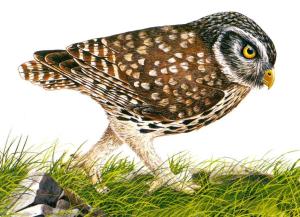
- Scientific Name: Athene cretensis
- Diet: Carnivorous/Insectivorous
- Where: Crete, Mediterranean
- When: Pleistocene
The Cretan Owl (Athene cretensis is an extinct species of owl from the Pleistocene of Crete, Mediterranean. In life, it would have been at least 2 feet tall, and flightless or nearly flightless. The Cretan Owl went extinct a while after humans began inhabiting Crete.
Cuban Giant Owl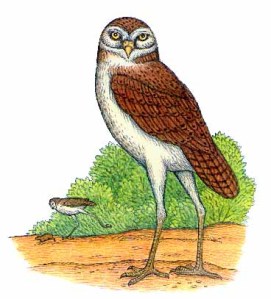
- Scientific Name: Ornimegalonyx
- Diet: Carnivorous/Insectivorous
- Where: Cuba
- When: Late Pleistocene
The extinct species of the Cuban Giant Owl was a flightless or nearly flightless bird and considered to be the largest owl that ever existed. Its habitat was restricted to the island of Cuba. The first fossil that was found was mistakingly described as a member of the terror bird family, due to the extremely large bone size. There’s a high number of fossils found on the island, particarly at the “Pío Dominga” cave, where three nearly complete skeletons were found.
The estimated height of the species was probably around 1.1 metres and its weight would have easily exceeded 9 kilos. The Cuban Giant owl might have even been able to kill prey of 35 kg or more. The owls were presumably strong runners, as they had very long legs and powerfully built feet. Their wings were slightly reduced, but they may have been capable of short bursts of flight, possibly in order to pounce on their prey.
Elephant Bird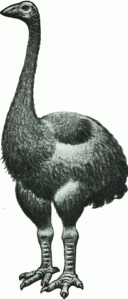
- Scientific Name: Aepyornis
- Diet: Carnivorous
- Where: Madagascar
- When: Quartinary
The Aepyornis elephant birds was a ground dwelling, flightless bird that also lived during the pleistocene. The bird was once the world’s largest bird until its extinction, about 1000 years ago. It weighed approximately 400 kg and was over 3 metres tall. Even recovered fossilised eggs were measured to have a circumference of over 1 meter.
The period of when the species died out is still unclear, as folktales of the giant birds might have persisted for some time. Their extinction has been largely blamed on the increase of human activity on the island. One theory states that the birds were hunted by humans, however, the species were led to extinction at a very fast rate. Another theory might seem more plausible: their eggs may have been the most vulnerable point in their life cycle. Especially their eggs appeared to serve as regular meals, as archeologists found many eggshells among the remains of human fires. In a BBC TV program, transmitted in early 2011, it was discussed that the reason why the elephant birds survived so long after the first arrival of man, could be attributed to the Malagasy native taboo against killing Aepyornis, but did not touch upon the habit of eating the eggs. So this theory remains unclear.
Genyornis
- Scientific Name: Genyornis Newtoni
- Diet: Carnivorous/Herbivorous
- Where: Australia
- When: Late Pleistocene
Genyornis was a large, flightless bird that lived in Australia until about 50 thousand years ago. This rough estimation coincides with the arrival of humans (their period of exinction is too short to be explained by climate change). The birds had incredibly large, crushing beaks, which may suggest that they were a combination of predators and scavengers. It was a relatively heavily built bird, probably over 2 metres tall, with tiny wings and extremely large hind legs.
The flightless bird primarily lived in open forest and savannah-grasslands and probably chose dunes as nesting sites, as many eggshell fragments were found in such places. Their preference for open areas could be explained by a shift to grasslands and increasing aridification. Sometimes fossils are found in groups, which suggests they liked to live in flocks.
In May 2010, archaeologists announced that they had rediscovered an Aboriginal rock art painting, possibly 40,000 years old, at the Nawarla Gabarnmung rock art site in the Northern Territory, that depicts two of the birds in detail. Other specialists concluded that the bird must have co-existed with humans for about 15 thousand years.
Giant Swan
- Scientific Name: Cygnus falconeri
- Diet: Herbivorous
- Where: Sicily, Malta
- When: Middle Pleistocene
The Giant Swan was a very large swan that lived around the area of Sicily and Malta (Mediterranean). It was a ground dwelling bird, well adapted for walking and had a length of about 190 to 210 cm, which indicates it may have been flightless. The Giant Swan exceeded the living Mute Swan’s dimensions by one third. It would have presumably weighed around 16 kg.
The Giant Swan went extinct before the increase of human activity in the area, which indicates the swan species probably died out because of extreme climate fluctuations or the arrival of superior preditors.
Haast’s Eagle
- Scientific Name: Harpagornis moorei
- Diet: Carnivorous
- Where: New Zealand
- When: Pleistocene
The Haast’s Eagle was a volant bird of prey that lived on the South Island of New Zealand during the Pleistocene. This giant eagle with a weight of 20 kilos and a wingspan of 2.6 meters is considered to have been the largest eagle ever.
Its habitat was coverd with forests, so the bird developed short, broad wings to actively fly through the forest and manoeuvre its large body between the trees and branches. It has been estimated that the eagle could reach a speed of 80 km/h. Haast’s Eagle hunted exceptionally large prey, sometimes even larger than himself. As archeologists noticed claw impressions on Moa skeletons, it was discovered that the eagle’s main preys included the moa’s, giant flightless birds, which could weigh over 200 kg (see below). These Moas were vulnarable for air attacks, because of their slow pace, small head and long neck. The reason why Haast’s Eagle hunted such large preys can be contributed to the fact that they were the largest carnivore in the area, so the bird species was in fact at the top of the food-chain.
The Haast’s Eagle became extinct around 1400 A.D., mainly because of an increase in human activity. Their major food sources were hunted by the Maori people and its habitat sharply decreased, as forests were cleared.
Moas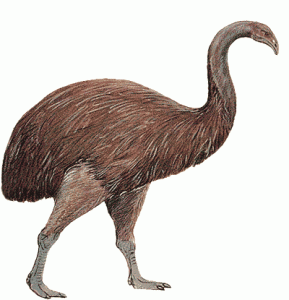
- Scientific Name: Dinornithiformes
- Diet: Carnivorous
- Where: New Zealand
- When: Miocene-Holocene
The ground dwelling, flightless Moa bird family comprised of eleven species endemic to New Zealand. The two largest species, Dinornis robustus and Dinornis novaezelandiae, generally reached about 3.7 metres in height (with neck outstretched), and must have weighed around 230 kg.
Moa birds were not only flightless, they didn’t have wings at all. This raises questions to how the Moas first arrived in New Zealand. Some scientists suggest the bird species must have already been present before New Zealand broke away from Antarctica about 70 million years ago.
They are considered to have been the dominant herbivores in New Zealand’s forest and shrubland for thousands of years (as well as during the Pleistocene), with their only predator being the Haast’s Eagle. This was until the arrival of the Maori, somewhere before 1300 A.D. Many Maori legends were about the huge and powerful bird, often describing how the Moas killed many warriors in great battles. It is generally accepted that most Moa birds went extinct by Maori hunting and habitat decline before European settlement.
Teratornis
- Scientific Name: Teratornis merriami
- Diet: Carnivorous
- Where: North America
- When: Early Pleistocene – Late Pleistocene
Teratornis was a huge North American bird of prey, with Teratornis merriami being the best known. It presumably had a wingspan of around 3.5 to 3.8 metres, was an estimated 75 cm tall and weighed about 15 kg. Fossils have been found at locations in California, southern Nevada, Arizona and Florida. Teratornis was probably most dispersed during the Late Pleistocene.
The species most likely went extint during the climatic shift of the most recent glacial period, which led to widespread ecological transitions. This climte change and increasing human influence (hunting and habitat change) resulted in prey scarcity, which led the Teratornis to eventually become extinct.
Titanis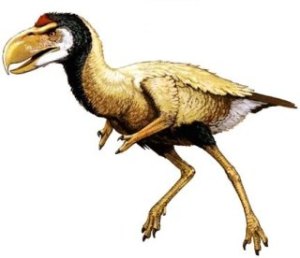
- Scientific Name: Titanis
- Diet: Carnivorous
- Where: North America
- When: Pliocene – Early Pleistocene
Titanis was a incredibly large, flightless bird species, endemic to North America. It originates from the Pliocene and went extinct in the earliest period of the Pleistocene, existing approximately 3.1 million years. The bird was about 2.5 metres tall and weighed about 150 kg. It probably had a huge, axe-like beak and although flightless, it still had tiny wings on its sides. It has been estimated that Titanis could run up to a speed of 65 km/h.
Comments on: "Birds" (7)
Outstanding post, I conceive blog owners should learn a lot from this web site its very user pleasant. So much superb information on here :D.
Only wanna comment on few general things, The website design is perfect, the subject matter is really superb : D.
Thank you very much for contributing to the project mcolmo! We will certainly take a look at these links. You seem like a kind-hearted person, having rescued pets. Puerto Rico is indeed a very relevant area for our Pleistocene Project, with a rich history of prehistoric fauna, so thanks again for your input!
You’re welcome!
I like your project. There used to be more birds where I live, and slowly they’ve become extinct. It’s so sad. Maybe I can send a couple of links in case you’re interested. There also used to be a ground sloth and other rodents that are now gone. Wish I could have met them.
Our information about Pleistocene birds is limited and we’re also going to write a section about ground sloths, so please do send us your link! Where exactly do you live? 🙂
Hi, I live in San Juan, Puerto Rico. I love animals. I have 3 cats and a lovebird. All of them rescued! Even the lovebird. He showed up one day on my front lawn and I set up a trap to catch him. He should be grateful I did, because this was a few days before hurricane Irene walked over us, so the poor birdie wouldn’t have survived all that rain! Anyhow, here is the link to the Puerto Rican ground sloth we used to have, you may have to scroll down to see the illustration:
http://www.amnh.org/science/biodiversity/extinction/Resources/Bestiary/Xenarthra.html
And here, you will find more information about many birds and other endemic fauna we have or used to have (sadly).
http://www.enotes.com/topic/List_of_endemic_fauna_of_Puerto_Rico
Hope you enjoy those!